After six years of Hubble Space Telescope observations and the hypothesis that millions of black holes exist in the Milky Way, scientists have finally found direct evidence for the existence of one such black hole. Plus, planetary formation, a wandering star, and this week in rocket history, we look back at China’s first crewed space station docking.
Podcast
Show Notes
Strange sulfur at Venus not a sign of life
- University of Cambridge press release
- “Proposed energy-metabolisms cannot explain the atmospheric chemistry of Venus,” Sean Jordan, Oliver Shorttle, and Paul B. Rimmer, 2022 June 14, Nature Communications
Planetary debris disk is… complicated
- NRAO press release
- “ALMA Images the Eccentric HD 53143 Debris Disk,” Meredith A. MacGregor et al., to be published in The Astrophysical Journal Letters (preprint)
Chinese rover discovers water on Moon
- CAS press release
- “Evidence of water on the lunar surface from Chang’E-5 in-situ spectra and returned samples,” Jianjun Liu et al., 2022 June 14, Nature Communications
Found family found among stars
- Northwestern press release
- “The Twisted Magnetic Field of the Protobinary L483,” Erin G. Cox et al., 2022 June 13, The Astrophysical Journal
Rogue object found not-shining in our galaxy
- ESA Hubble press release
- Hubblesite press release
- NASA press release
- UC Berkeley press release
- “An Isolated Stellar-Mass Black Hole Detected Through Astrometric Microlensing,” Kailash C. Sahu et al., to be published in The Astrophysical Journal (preprint)
- “An isolated mass gap black hole or neutron star detected with astrometric microlensing,” Casey Y. Lam et al., to be published in The Astrophysical Journal Letters (preprint)
This Week in Rocket History: Shenzhou-9
- Insider: Tiangong 1 to launch in early Sept. (People’s Daily Online)
- China successfully completes space docking (China Daily Europe)
- Chinese spacecraft Shenzhou 9 makes first manual docking with space module (The Guardian)
- Shenzhou 9 info page (Astronautix)
Transcript
Apparently, news of a new black hole scared everyone away.
Or at least the heat from the awesomeness of the science killed Erik’s computer. And so I’m hosting solo.
The Universe is full of surprises. Like planetary debris disks that aren’t as expected and stars wandering through stellar nurseries.
And more water on the Moon!
And we’ve even got some rocket history.
All of this now, right here on the Daily Space.
I am your host Dr. Pamela Gay.
And we’re here to put science in your brain.
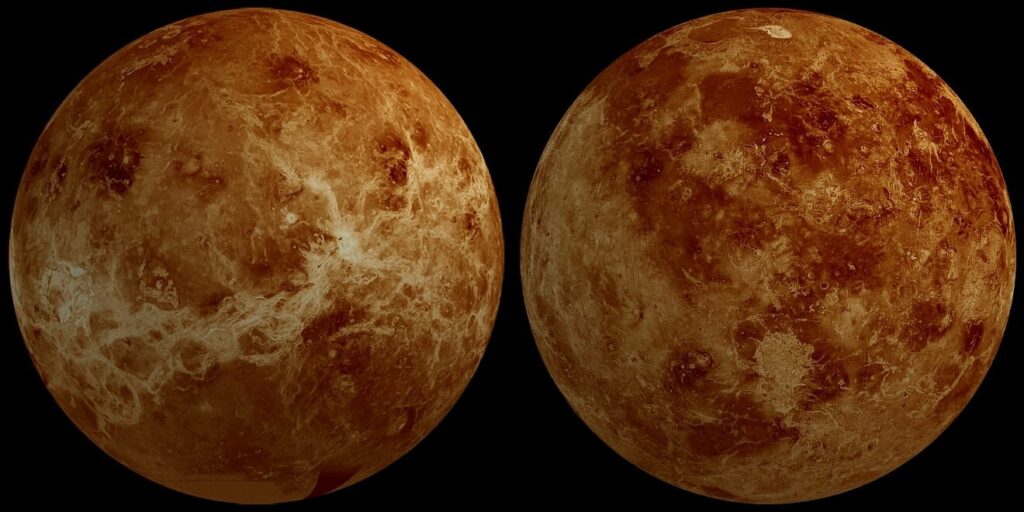
With NASA and the European Space Agency (ESA) gearing up to explore Venus in more detail, scientists continue to explain strange discoveries in the Venusian atmosphere. This time, a team of researchers tested the hypothesis that some unusual type of cloud-based life was causing elevated levels of sulfur dioxide. Their findings, published in Nature Communications, basically answer… no. We’re not looking at a biological process.
Of course, all the hullabaloo over phosphine in the atmosphere and the Jurassic Park quoting of “life finds a way” keeps researchers excited to examine all the possibilities. Co-author Paul Rimmer notes: Life is pretty good at weird chemistry, so we’ve been studying whether there’s a way to make life a potential explanation for what we see.
To explore this particular hypothesis, the team combined atmospheric and biochemical models and studied the various chemical reactions. If sulfur is being used as a food source from some exotic form of life, they thought, then there should be evidence in the chemical composition of the atmosphere. Nutrients taken in mean energy produced and waste products expelled, after all.
First, we have to compare Venus to Earth. On Earth, our atmospheric sulfur dioxide is the result of volcanic activity. Venus has volcanoes, possibly even active ones, that could be supplying the atmosphere with sulfur dioxide on an ongoing basis. That sounds reasonable enough. But then, at higher levels in the atmosphere, the sulfur dioxide disappears. So perhaps drops in sulfur dioxide were due to consumption.
Next, the team added metabolic reactions to the model that would result from life possibly consuming sulfur dioxide and producing those waste products. And then they checked the data from Venus’s atmosphere to see if those particular molecules were present.
It turns out that yes, the metabolic reactions could produce the drop in sulfur dioxide seen; however, the by-products released just aren’t present in the quantities necessary to indicate life. First author Sean Jordan explains: If life was responsible for the SO2 levels we see on Venus, it would also break everything we know about Venus’s atmospheric chemistry. We wanted life to be a potential explanation, but when we ran the models, it isn’t a viable solution. But if life isn’t responsible for what we see on Venus, it’s still a problem to be solved—there’s lots of strange chemistry to follow up on.
And some of that follow-up could be done with JWST because our newest telescope (well, almost) is really sensitive to these types of sulfur molecules. Life or not, Venus is incredibly fascinating.

One of the interesting facets of Venus is that we haven’t found anything like it elsewhere in the galaxy. To be fair, we haven’t found anything that’s really like Earth, either. We’re just not to that point in our observations, yet, as much as we would like to be. Let’s face it — we’re still trying to sort out the whole planetary formation issue.
This week, that issue got a bit more complicated as researchers presented observations of a planetary debris disk to the 240th meeting of the American Astronomical Society (AAS). And the observations were not what was expected or predicted.
The parent star involved is HD 53143. Scientists used the Atacama Large Millimeter/submillimeter Array (ALMA) to image the star’s debris disk, which was discovered in Hubble observations back in 2006. The debris disk was thought to be similar to our own Kuiper Belt — smaller bodies and comets engaged in a game of cosmic billiards, grinding each other down. And based on the Hubble observations, the debris disk was thought to be basically face-on from our view on Earth. That all seemed simple enough.
Until ALMA came along.
Now it appears that this system has not only a highly eccentric debris disk but possibly a second disk and even a planet. Lead researcher Meredith MacGregor explains: Until now, scientists had never seen a debris disk with such a complicated structure. In addition to being an ellipse with a star at one focus, it also likely has a second inner disk that is misaligned or tilted relative to the outer disk. In order to produce this structure, there must be a planet or planets in the system that are gravitationally perturbing the material in the disk.
These new observations mean that HD 53143 is the most eccentric debris disk found to date. This result is unexpected, definitely unusual, and means something must be perturbing the disk – something like a planet, perhaps.
Understanding how this particular system got its shape is another piece of the planetary formation process, which seems to be more like a tree with lots of branches than a “one solution fits all” kind of theory. As Dr. Joe Pesce from the NSF notes: This research demonstrates how astronomy works and how progress is made, informing not only what we know about the field but also about ourselves.
Unlike the landers on Mars which can get covered in dust from wind storms, landers on the Moon don’t. That’s not to say they don’t face other issues, but the Chinese lander Chang’e 5 has been working on the Moon since its December 2020 landing. However, being a stationary lander wasn’t the main purpose. The main purpose of the mission was to collect and return a sample from the Moon back to Earth. New results from the Chinese Academy of Sciences study both the samples and other data the lander took while on the surface. And the result is water… or something pretty close to it.
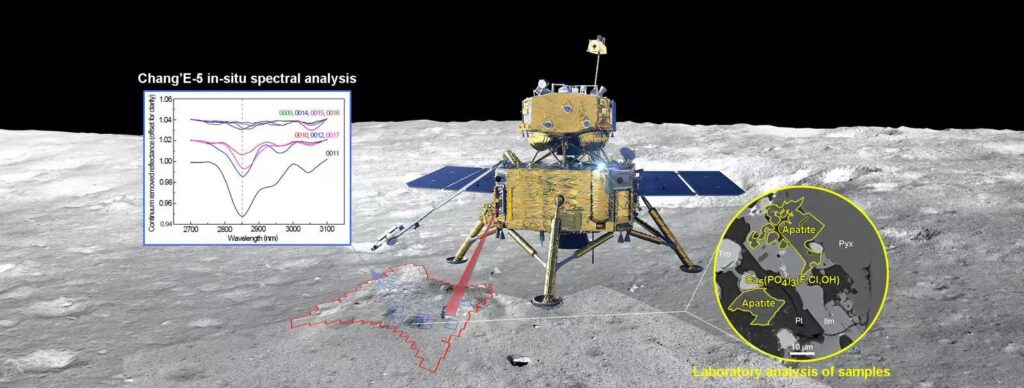
The “water” source detected was contained in the structure of a mineral called apatite and was 30 parts per million of hydroxyl. Hydroxyl is only one hydrogen and one oxygen, not two hydrogens and one oxygen like regular water. According to scientists, this molecule is what happens when water undergoes photochemical reactions, or reactions involving sunlight. The lunar hydroxyl was discovered in eleven rock and soil samples studied directly by the lander on the lunar surface and confirmed in eight of those samples during laboratory research back on Earth.
The researchers tried to identify other possible sources for this detection. As the sample was collected when the moon was really hot, it should have been dry. Part of the explanation could be from a chemical reaction catalyzed by the solar wind. Apollo moon rocks from Oceanus Procellarum have similar materials. However, the solar wind was not as strong in 2020 as other times when it caused hydration of lunar rocks, so not all the hydroxyl could be explained, which means the rest of the ‘water’ had to come from the moon itself. This water could have influenced the formation of lunar rocks, particularly in the “late lunar” period.
According to project scientist Li Chunlai: By investigating lunar water and its source, we are learning more about the formation and evolution of not just the Moon itself, but also the solar system. In addition, lunar water is expected to provide support for future human lunar in-situ resources.
These results will be followed up by Chang’E 6 and 7.
Coming up next, a wandering star and a rogue black hole.
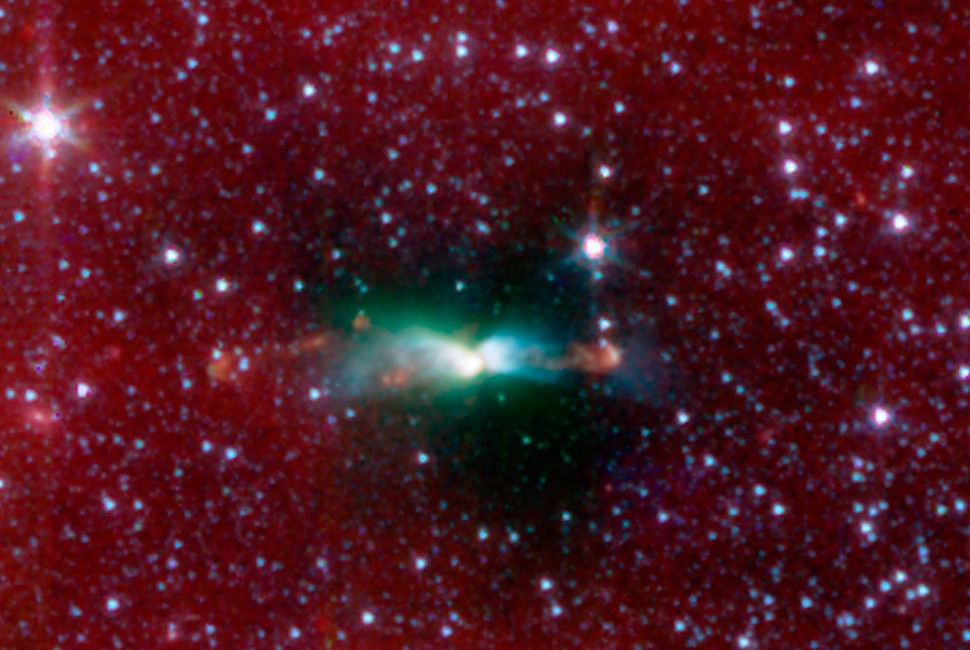
In our last episode, we brought you the news that the Gaia mission had increased the number of known binary star systems in our galaxy from 300,000 to 800,000. How all those stars formed — we have part of that answer today.
In many, and perhaps most, cases, these two-star systems formed when a collapsing cloud of gas fragments into two orbiting pieces. Each cloud fragment will form its own star, but these objects will end up gravitationally bound together as they orbit the galaxy. These systems can end up with planets around each individual star or orbiting both stars, allowing for us to imagine a real-life double sunset like Luke watched on Tatooine.
We also know that in the eldest globular clusters, stars can pass so closely together that they can gravitationally grab onto one another, creating new binary systems, and sometimes even merging into new stars.
In birth, and in death, binaries come together.
But a new paper coming out in The Astrophysical Journal shows us that just like people can have found family early in life, so too can stars.
Observers looking at the young star L483 expected to find a single star with a single well-behaved magnetic field that aligned with the star’s inflowing gas. At the largest scales, this is exactly what was seen, but in higher detailed images taken with the SOFIA Airborne Observatory, kinks in the magnetic field were revealed, and with them, a hidden companion star. According to lead researcher Erin Cox: We think these stars formed far apart, and one moved closer to the other to form a binary. When the star traveled closer to its sibling, it shifted the dynamics of the cloud to twist its magnetic field. … We don’t know why one star would move toward another one, but we think the moving star shifted the dynamics of the system to twist the magnetic field.
Found family, y’all. That second star? It was hungry and needed a home and found one by snuggling up next to an adopted sibling. Separated by about the same distance as the Sun and Pluto, these two stars are now growing up together, consuming material in a shared stellar nebula. Time will tell if they go on to share planets and solar systems.
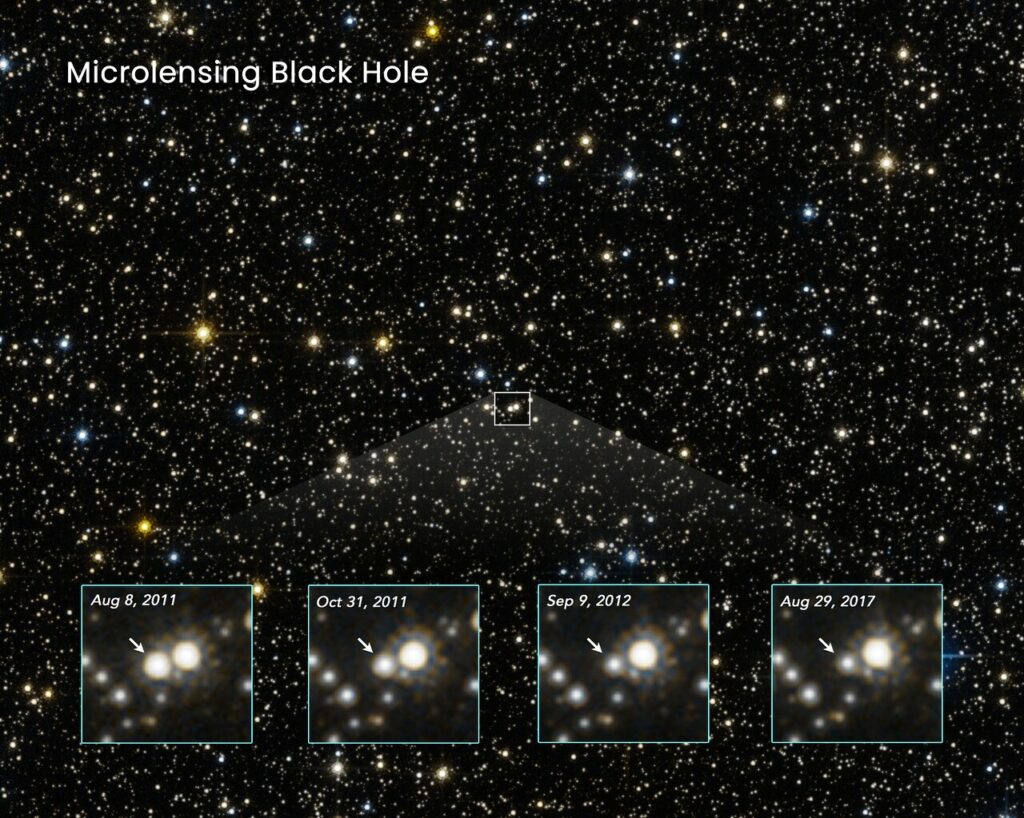
A shocking amount of astronomy is trying to figure out what is out there refusing to be seen. From hidden stars to hidden matter, researchers are turning to the forces to find what’s missing. From those kinked magnetic fields to gravity pointing out hidden mass, the forces can show us what light sometimes leaves hidden.
In an ongoing study, researchers image the sky toward the densely packed center of our galaxy on a regular basis looking for distant stars to suddenly brighten as a relatively nearby star passes between us and it. This geometry allows the nearer object’s gravity to bend light that would normally head off toward other parts of the galaxy toward us, creating the brightening. This has proven to be a great way to get a census of the small and the faint that otherwise would go unnoticed. And since objects of different masses are able to bend different amounts of light, this technique allows us to get a sense of how big all those not-exactly shiny objects may be.
In 2011, a brightening event of unusual size was spotted. For 270 days, something radically brightened a background star, and in the decade since that initial brightening, researchers have leveraged both ground and space-based telescopes to figure out exactly what was responsible. During the brightening event, researchers saw none of the normal color variations that occur when a faint foreground star mixes its light with a background object. Whatever this object is, it is dark.
Observations have shown the light of the background object goes from radically brightened to appearing in a new and changing position. This evolving offset from where it had previously been mapped is another consequence of gravity. A large enough mass will warp space and distort positions the same way a funhouse mirror can distort your face. By watching how these distortions evolved, it became possible to calculate the hidden mass’ size and motion.
And here is where things get messy. This object was studied by two different teams, and one team determined the best fit solution that has the object fairly nearby, flying along at under 30 km/s and having a mass of 1.6-4.4 times the mass of our Sun. This kind of mass means it is either a neutron star or a small black hole.
A different team instead finds a larger distance, a speed of more like 45 km/s, and a mass of more than seven solar masses. Both these scenarios are consistent with a massive star dying as a supernova and the energy of that SN rocketing the remaining stellar core on a trajectory across the galaxy. If this is a neutron star, this is the first neutron star found using just gravity. If this is a black hole, this is the first black hole found without a companion.
It is unknown how many black holes may be out there, rocketing through space darkly. The number is not small, but at least one of them may have finally been found.
The results of these two teams are published in a pair of papers available on arxiv.org and led by Kailash Sahu and Casey Lam.
Up next, we turn from today’s science to yesterday’s exploration with “This Week in Rocket history.”
This Week in Rocket History
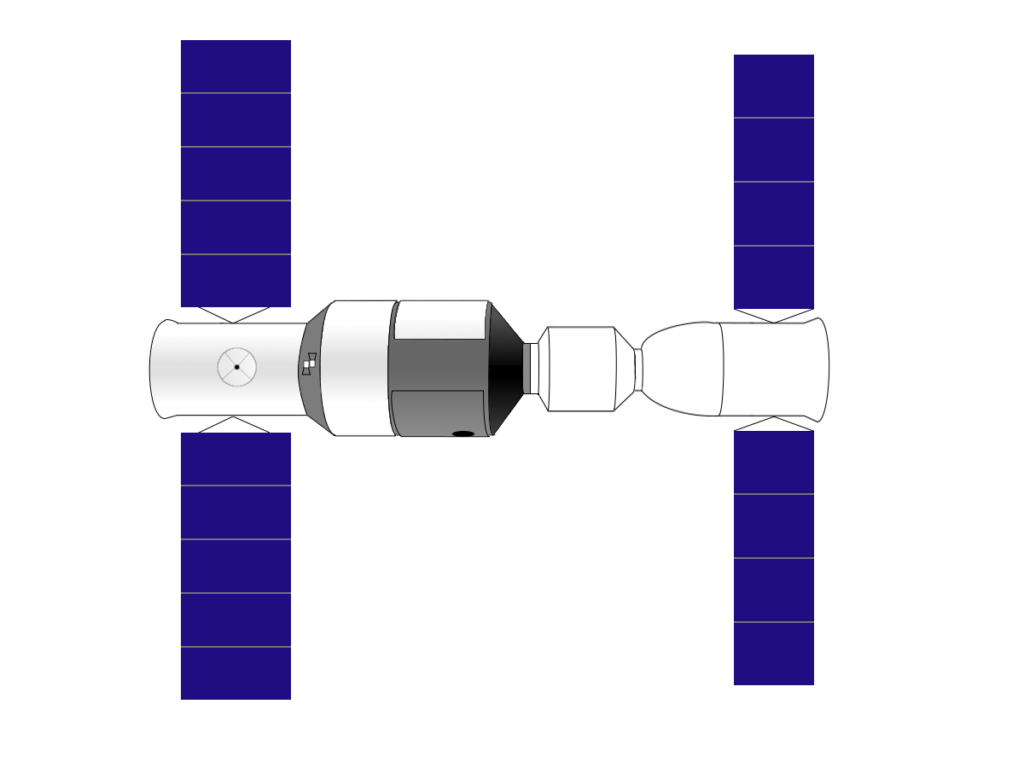
We’ve covered several other Shenzhou missions, and This Week in Rocket History is Shenzhou-9, the first crewed space station docking of the Chinese program.
China’s space program works in much the same way the early Soviet program did: a mix of uncrewed test flights to prove new capabilities with lower risk, followed by crewed flights. For example, Shenzhou-1 through 4 were uncrewed missions demonstrating different aspects of the Shenzhou spacecraft and launch vehicle before it was trusted with a crew on Shenzhou-5. Then Shenzhou-6 had two crew members before Shenzhou-7 finally had the full design complement of three crew members.
Their space station program has followed this model, too.
Tiangong-1 was China’s first space station. As stations go, it was pretty small, and it was launched by the same rocket that would be used for the crewed Shenzhou spacecraft which would visit it. Launched in 2011, it was first visited by the uncrewed Shenzhou-8 spacecraft to demonstrate the docking port before the crewed Shenzhou-9 spacecraft launched.
Shenzhou-8 was a milestone in and of itself, making China only the third space agency to demonstrate completely autonomous rendezvous and docking, behind the Soviet Union and the European Space Agency. The spacecraft performed two dockings during the mission. The first was during the orbital night because of concerns of glare from the sun confusing the docking sensors. The second docking, a few days after the first, was done in sunlight to prove the sensors would work in the more challenging conditions. Shenzhou-8 returned to Earth successfully at the end of the flight carrying a small biological payload in the return module.

Shenzhou-9 launched on June 16, 2012. This was 49 years to the day of the launch of Vostok-6 with the first woman in space, Valentina Tereshkova, and was chosen because of the crew of Shenzhou-9, which included the first Chinese woman astronaut, Liu Yang, and the first Chinese astronaut to go into space more than once, Jing Haiping. It automatically docked to Tiangong-1, two days after launch on June 18.
Three hours after docking, the pressure between the spacecraft was finally equalized and it was safe to board. The crew opened the hatch to Tiangong-1, and over the next six days conducted many scientific experiments.
On the sixth day of the mission, Shenzhou-9 undocked, and after an hour of free flight, Liu Yang guided it back to Tiangong-1 for manual docking, which was successful. This was an essential demonstration for the space station program. It’s not good to rely on an automatic system in case it has any problems.

Shenzhou-9 remained docked for another six days while the crew continued scientific research. One of the experiments was to determine if medicine had different potency in space compared to on the ground. In space, the dosage might need to be changed to have the same effect. In the test on Shenzhou-9, they used the common painkiller paracetamol, also known as acetaminophen. Acetaminophen was chosen because it’s easy to detect in saliva, according to the Astronaut Center of China. The astronauts took the medicine in flight as normal and were examined afterward on the ground. I was unable to locate the post-flight results of this experiment, but as two of the three astronauts conducted subsequent missions into space, it’s likely they were not harmed.
Shenzhou-9 undocked on June 28, 2012, and reentered on the same day. Before they reentered, the crew performed another manual rendezvous, back to 140 meters, before departing for good.
Statistics
And now, for some statistics.
The number of toilets in space is eight: four on the ISS, one on Soyuz MS-21, one on the Crew Dragon Freedom, one on Tianhe, and one on Shenzhou-14. We keep track of orbital launches by launch site, also called spaceport. Here’s that breakdown:

USA 32
China 18
Russia 5
Kazakhstan 4
New Zealand 3
India 1
Iran 1
From those 64 launches, a total of 1,042 spacecraft were put into orbit.
Your random space fact for this week is that the International Space Station‘s twelve EXpedite the PRocessing of Experiments to the Space Station or EXPRESS racks (because astronomers should not name things) have been powered on for one million hours as of June 14, 2022. That’s a little over 114 years total. For reference, the first EXPRESS rack was launched in 1998, 24 years ago.
This has been the Daily Space.
You can find more information on all our stories, including images, at DailySpace.org. As always, we’re here thanks to the donations of people like you. If you like our content, please consider joining our Patreon at Patreon.com/CosmoQuestX.
Credits
Written by Pamela Gay, Beth Johnson, Erik Madaus, and Gordon Dewis
Hosted by Pamela Gay, Beth Johnson, and Erik Madaus
Audio and Video Editing by Ally Pelphrey
Content Editing by Beth Johnson
Intro and Outro music by Kevin MacLeod, https://incompetech.com/music/


 We record most shows live, on Twitch. Follow us today to get alerts when we go live.
We record most shows live, on Twitch. Follow us today to get alerts when we go live.